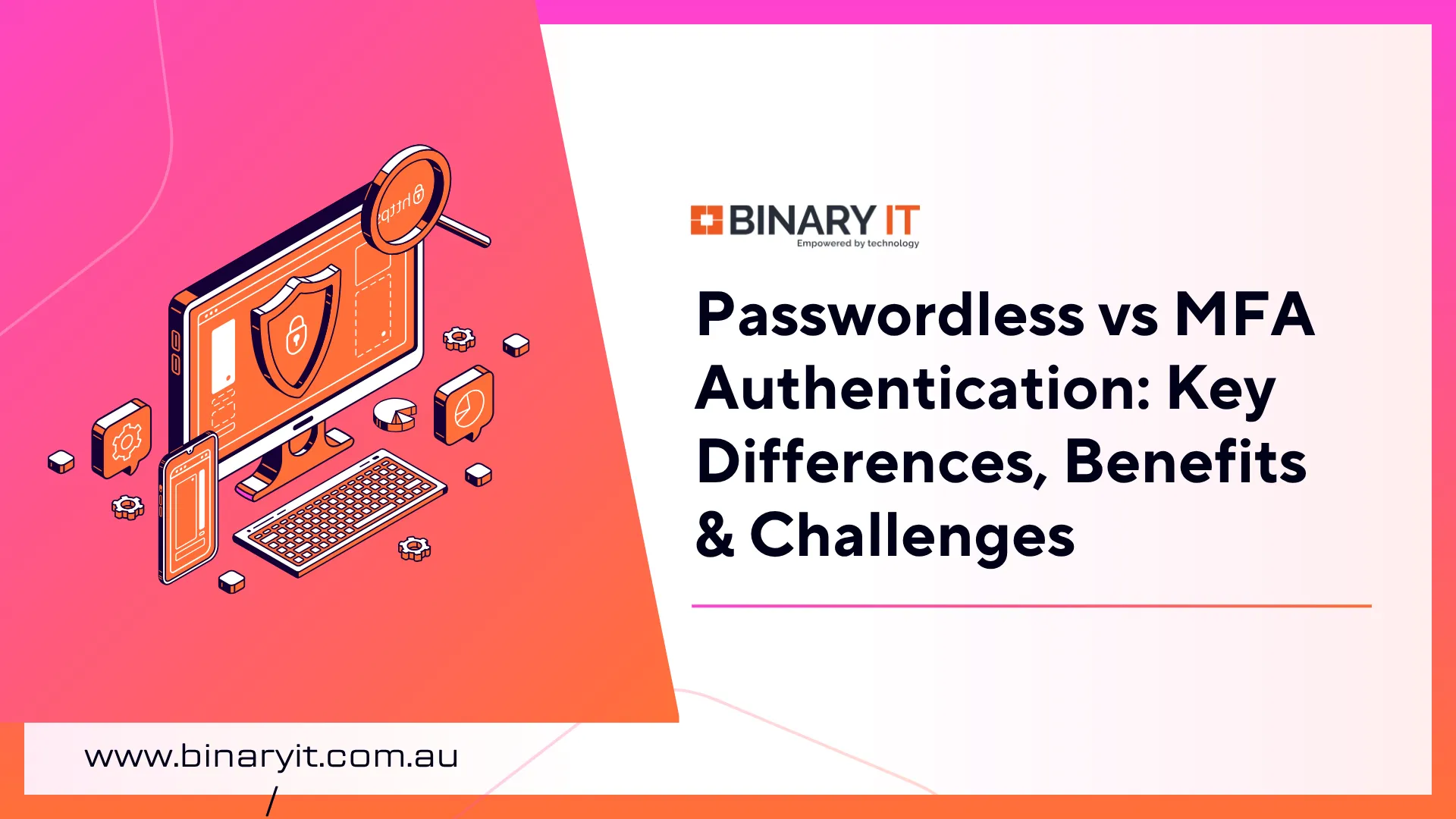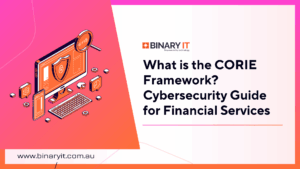“What if the very passwords you rely on to protect your business are the weakest link in your security?”
Every year, millions of accounts in Australia and around the world are compromised, not because hackers are geniuses, but because passwords are easy to guess, reuse, or steal. Multi-factor authentication (MFA) added a second line of defence, but even that isn’t foolproof.
This is where passwordless authentication comes in, an innovative method that does away with passwords altogether, using biometrics, cryptographic keys, and secure devices instead.
In this blog, we’ll explore the key differences between MFA and passwordless authentication, examine their benefits and challenges, and help you implement a secure, user-friendly solution that protects your systems without slowing productivity.
What is Multi-Factor Authentication (MFA)?
Multi-factor authentication requires users to provide two or more authentication factors to gain access to systems or applications. These factors typically fall into three categories:
Something you know (passwords, PINs), something you have (smartphones, hardware tokens), and something you are (biometrics like fingerprints or facial recognition).
Common MFA implementations include:
- SMS one-time passwords (OTPs)
- Authenticator apps (Microsoft Authenticator, Google Authenticator)
- Hardware security keys
- Push notifications to registered devices
The ACSC strongly endorses MFA implementation through the Essential Eight framework. MFA is required for privileged and unprivileged access to servers. Any ISM permitted phishing-resistant multi-factor authenticator can be used to achieve maturity level 3. This guidance aligns with international standards from NIST and other cybersecurity authorities.
What is Passwordless Authentication?
Passwordless authentication eliminates passwords, replacing them with cryptographic key pairs and biometric verification. FIDO2 provides passwordless, secure login based on a public-private key pair. When a user registers with a service, their device generates these keys, storing the private key securely and sending the public key to the service.
Key passwordless authentication methods include:
- FIDO2/WebAuthn: The open standard enabling passwordless authentication across web applications and services
- Passkeys: FIDO2 is a set of standards for secure, passwordless online authentication, while passkeys are an implementation of these standards, commonly known as FIDO multi-device credentials.
- Device-bound credentials: Biometric authentication (Face ID, Windows Hello, fingerprint scanners) combined with secure hardware elements
- Hardware security keys: Physical devices that store cryptographic credentials and require user presence verification
The authentication process is elegantly simple: users authenticate to their device using biometrics or a PIN, then the device cryptographically signs the login challenge. No passwords are transmitted or stored on servers, eliminating the most common attack vectors.
Passwords alone aren’t enough. Contact us to implement passwordless authentication and enhanced MFA solutions across your organisation, reducing risk, improving compliance, and protecting sensitive data.
How Does Passwordless Authentication Differ From Multi-Factor Authentication?
Authentication Flow Comparison
| Traditional MFA flow: | Passwordless flow: |
|
|
Key Differences Between Passwordless Authentication and Multi-Factor Authentication
While both MFA and passwordless authentication aim to strengthen security, they take very different approaches. Below, we break down how each works in practice and what sets them apart.
| Feature | MFA | Passwordless |
|---|---|---|
| Passwords | Usually required as the first step, leaving some risk of theft or phishing. | Eliminates passwords with biometrics, keys, or passkeys. |
| User Experience | Extra steps can slow logins and cause fatigue. | Faster, seamless logins with biometrics or devices. |
| Security | Stronger than passwords alone but vulnerable to SMS hacks or push fatigue. | Phishing-resistant; credentials never leave the device. |
| Recovery | Backup codes or secondary factors, but recovery channels can be exploited. | Device-based recovery; loss can be harder without backups. |
| Compatibility | Works with almost all apps, including legacy systems. | Best for modern apps (FIDO2/WebAuthn); may need hybrid rollout. |
Benefits of Multi-Factor Authentication (MFA)
MFA delivers immediate security improvements with relatively straightforward implementation:
Compliance Alignment: MFA satisfies most regulatory requirements and cybersecurity frameworks, including the ACSC Essential Eight. It’s recognised across Australian privacy legislation and industry standards.
Gradual Implementation: Organisations can deploy MFA incrementally across different systems and user groups, minimising disruption to business operations.
Technology Compatibility: Most legacy applications can integrate MFA through identity providers or gateway solutions, avoiding costly system replacements.
Cost-Effective Security: MFA significantly reduces security risks with manageable implementation costs, especially when using software-based authenticators.
Benefits of Passwordless Authentication
Passwordless authentication addresses fundamental security and usability challenges:
Superior Phishing Protection: Hardware-backed options like FIDO2 keys are starting to take centre stage in the shift toward passwordless authentication. FIDO2 uses public key cryptography to validate users based on possession of a private key instead of passwords. This approach eliminates credential-based phishing attacks.
Reduced IT Overhead: Password reset requests typically comprise 20-50% of helpdesk tickets. Eliminating passwords dramatically reduces support costs and improves IT team productivity.
Enhanced User Experience: Modern passwordless implementations offer seamless authentication through biometrics or simple device interactions, improving user satisfaction and reducing authentication friction.
Future-Proof Architecture: Its primary goal is to empower passwordless logins on websites and applications. Instead of relying on vulnerable passwords, FIDO2 leverages pairs of cryptographic keys, one stored privately on the user’s device and one registered with the service, ensuring credentials never leave the device.
Regulatory Alignment: Passwordless solutions align with emerging cybersecurity frameworks, prioritising phishing-resistant authentication methods.
Stay ahead of cybercriminals by adopting a robust authentication strategy. Contact us today to develop a phased approach combining MFA and passwordless authentication tailored to your business needs.
Practical Challenges & Risks
MFA Implementation Challenges
- SMS OTP Vulnerabilities: SIM swapping attacks and SMS interception make SMS-based MFA increasingly risky. The ACSC recommends moving beyond SMS for critical systems.
- Push Notification Fatigue: Users become conditioned to approve MFA prompts automatically, reducing security effectiveness. Recent high-profile breaches have exploited this behaviour.
- Account Recovery Complexity: MFA can create account lockout scenarios when users lose access to second factors, requiring robust recovery procedures.
- Legacy System Integration: Older applications may require significant modification or gateway solutions to support MFA properly.
Passwordless Implementation Challenges
- Device Loss/Recovery: This transitional strategy is particularly useful in industries with legacy systems that are not yet compatible with fully passwordless workflows. Organisations need device management and recovery procedures.
- Cross-Platform Synchronisation: While passkeys can sync across devices, this introduces complexity around cloud storage and potential vendor lock-in concerns.
- Legacy Application Support: Many enterprise applications weren’t designed for passwordless authentication, requiring significant integration work or hybrid approaches.
- User Training Requirements: Despite improved usability, users require education about new authentication methods and recovery procedures.
- Migration Complexity: Moving from password-based systems to passwordless requires careful planning, especially for organisations with complex IT environments.
How Should A Business Choose Between MFA and Passwordless?
When choosing between MFA and passwordless authentication, the right option depends on your security goals, system compatibility, and user experience requirements. Here’s a practical framework:
When to Choose MFA:
- Your business still relies heavily on legacy systems that don’t support passwordless standards, such as FIDO2/WebAuthn.
- You need a cost-effective, quick upgrade from basic passwords without major infrastructure changes.
- Regulatory frameworks (like the ACSC Essential Eight) require multi-factor authentication for compliance.
When to Choose Passwordless:
- Security is your top priority, particularly for high-risk systems (finance, healthcare, privileged accounts).
- You want to eliminate the risks of password theft, phishing, or credential stuffing.
- Your organisation is modernising IT systems and can adopt FIDO2, passkeys, or device-bound credentials.
When to Use a Hybrid Approach (MFA + Passwordless):
- You’re in a transition phase where some systems support passwordless while others don’t.
- You need to balance user convenience and compliance while modernising at a sustainable pace.
- You want strong security now, but also want to future-proof your organisation with a roadmap toward fully passwordless authentication.
Can I replace MFA with passwordless entirely?
Yes, for compatible systems. However, most organisations benefit from a hybrid approach during transition phases, using passwordless for essential systems while maintaining MFA for legacy applications and backup access.
Conclusion
Passwordless authentication and MFA aren’t competitors; they’re complementary tools in a layered security strategy. MFA adds extra verification beyond passwords, making it far stronger than relying on a single credential. Passwordless takes it a step further by eliminating passwords, replacing them with phishing-resistant methods like biometrics and cryptographic keys.
The main difference is that MFA still relies on passwords as a starting point, while passwordless removes them entirely, closing one of the biggest gaps in modern cybersecurity.
For most Australian organisations, the right path is a phased approach: use MFA where legacy systems demand it, while progressively adopting passwordless for critical or modern applications. This hybrid roadmap balances compliance, usability, and long-term resilience.
Ready to enhance your organisation’s authentication security? Contact our cybersecurity expert to help you develop a tailored roadmap that balances security, usability, and compliance requirements specific to your Australian operations.





